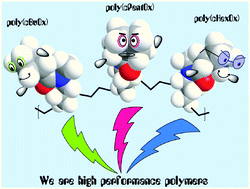Poly(2-cycloalkyl-2-oxazoline)s: high melting temperature polymers solely based on Debye and Keesom van der Waals interactions†
Abstract
The synthesis of new 2-cycloalkyl-2-oxazoline monomers, namely 2-cyclobutyl (cBuOx), 2-cyclopentyl (cPentOx) and 2-cyclohexyl-2-oxazoline (cHexOx) is described. Their microwave-assisted cationic ring-opening polymerisation allowed the synthesis of well-defined homopolymers. The resulting homopolymers are crystalline and have high chemical resistance to organic solvents. The highest melting point was registered for cPentOx (306 °C), followed by cHexOx (251 °C) and cBuOx (243 °C). The crystal structure of the homopolymers was put into evidence by X-ray diffraction and appeared to be similar to that of the poly(2-isopropyl-2-oxazoline). The absence of any hydrogen bonding or π–π interactions, makes these compounds a special class of high performance polymers which possess high Tm solely based on Debye and Keesom van der Waals interactions of the side-chains. The copolymerization of cPentOx with 2-ethyl-2-oxazoline (EtOx) and cBuOx, respectively are also reported indicating the formation of near ideal random copolymers. Furthermore, the copolymers of cPentOx with cBuOx with compositions in the range from 0 to 100% revealed a linear dependence of melting temperature with the weight fraction of comonomer. For cPentOx-EtOx copolymers containing up to 25 wt% EtOx a linear decrease of the melting temperature with composition was registered, most likely due to the disturbance of the cPentOx crystalline domains. Further, increasing the EtOx wt% revealed a complex non-linear dependence of glass transition temperature on composition, whereby the glass transition temperature of some copolymers was lower than for pure PEtOx.


 Please wait while we load your content...
Please wait while we load your content...